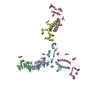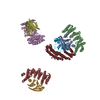[English] 日本語
 Yorodumi
Yorodumi- SASDAB8: Protein Interacting with C-kinase 1 (PICK1) LKV, dimer contributi... -
+ Open data
Open data
- Basic information
Basic information
| Entry | Database: SASBDB / ID: SASDAB8 |
|---|---|
 Sample Sample | Protein Interacting with C-kinase 1 (PICK1) LKV, dimer contribution (data decomposition).
|
| Function / homology |  Function and homology information Function and homology informationG protein-coupled glutamate receptor binding / membrane curvature sensor activity / glial cell development / cellular response to decreased oxygen levels / Arp2/3 complex binding / postsynaptic specialization / regulation of Arp2/3 complex-mediated actin nucleation / postsynaptic endocytic zone / negative regulation of Arp2/3 complex-mediated actin nucleation / dopamine transport ...G protein-coupled glutamate receptor binding / membrane curvature sensor activity / glial cell development / cellular response to decreased oxygen levels / Arp2/3 complex binding / postsynaptic specialization / regulation of Arp2/3 complex-mediated actin nucleation / postsynaptic endocytic zone / negative regulation of Arp2/3 complex-mediated actin nucleation / dopamine transport / SNAP receptor activity / monoamine transport / dendritic spine organization / long-term synaptic depression / dendritic spine maintenance / regulation of postsynaptic neurotransmitter receptor internalization / receptor clustering / Trafficking of GluR2-containing AMPA receptors / positive regulation of receptor internalization / protein targeting / cellular response to glucose starvation / cytoskeletal protein binding / ephrin receptor binding / ionotropic glutamate receptor binding / regulation of insulin secretion / protein kinase C binding / trans-Golgi network membrane / intracellular protein transport / G protein-coupled receptor binding / receptor tyrosine kinase binding / phospholipid binding / actin filament binding / synaptic vesicle / presynaptic membrane / GTPase binding / dendritic spine / cytoskeleton / protein phosphorylation / neuron projection / postsynaptic density / signaling receptor binding / protein domain specific binding / negative regulation of gene expression / dendrite / synapse / perinuclear region of cytoplasm / glutamatergic synapse / Golgi apparatus / protein-containing complex / mitochondrion / metal ion binding / identical protein binding / plasma membrane / cytoplasm Similarity search - Function |
| Biological species |  |
 Citation Citation |  Journal: Structure / Year: 2015 Journal: Structure / Year: 2015Title: Structure of Dimeric and Tetrameric Complexes of the BAR Domain Protein PICK1 Determined by Small-Angle X-Ray Scattering. Authors: Morten L Karlsen / Thor S Thorsen / Niklaus Johner / Ina Ammendrup-Johnsen / Simon Erlendsson / Xinsheng Tian / Jens B Simonsen / Rasmus Høiberg-Nielsen / Nikolaj M Christensen / George ...Authors: Morten L Karlsen / Thor S Thorsen / Niklaus Johner / Ina Ammendrup-Johnsen / Simon Erlendsson / Xinsheng Tian / Jens B Simonsen / Rasmus Høiberg-Nielsen / Nikolaj M Christensen / George Khelashvili / Werner Streicher / Kaare Teilum / Bente Vestergaard / Harel Weinstein / Ulrik Gether / Lise Arleth / Kenneth L Madsen /   Abstract: PICK1 is a neuronal scaffolding protein containing a PDZ domain and an auto-inhibited BAR domain. BAR domains are membrane-sculpting protein modules generating membrane curvature and promoting ...PICK1 is a neuronal scaffolding protein containing a PDZ domain and an auto-inhibited BAR domain. BAR domains are membrane-sculpting protein modules generating membrane curvature and promoting membrane fission. Previous data suggest that BAR domains are organized in lattice-like arrangements when stabilizing membranes but little is known about structural organization of BAR domains in solution. Through a small-angle X-ray scattering (SAXS) analysis, we determine the structure of dimeric and tetrameric complexes of PICK1 in solution. SAXS and biochemical data reveal a strong propensity of PICK1 to form higher-order structures, and SAXS analysis suggests an offset, parallel mode of BAR-BAR oligomerization. Furthermore, unlike accessory domains in other BAR domain proteins, the positioning of the PDZ domains is flexible, enabling PICK1 to perform long-range, dynamic scaffolding of membrane-associated proteins. Together with functional data, these structural findings are compatible with a model in which oligomerization governs auto-inhibition of BAR domain function. |
 Contact author Contact author |
|
- Structure visualization
Structure visualization
| Structure viewer | Molecule:  Molmil Molmil Jmol/JSmol Jmol/JSmol |
|---|
- Downloads & links
Downloads & links
-Data source
| SASBDB page |  SASDAB8 SASDAB8 |
|---|
-Related structure data
| Similar structure data |
|---|
- External links
External links
| Related items in Molecule of the Month |
|---|
-Models
| Model #318 |  Type: mix / Software: EOM / Radius of dummy atoms: 1.90 A / Chi-square value: 3.818116  Search similar-shape structures of this assembly by Omokage search (details) Search similar-shape structures of this assembly by Omokage search (details) |
|---|---|
| Model #319 |  Type: mix / Software: EOM / Radius of dummy atoms: 1.90 A / Chi-square value: 3.818116  Search similar-shape structures of this assembly by Omokage search (details) Search similar-shape structures of this assembly by Omokage search (details) |
| Model #322 |  Type: mix / Software: EOM / Radius of dummy atoms: 1.90 A / Chi-square value: 3.818116  Search similar-shape structures of this assembly by Omokage search (details) Search similar-shape structures of this assembly by Omokage search (details) |
- Sample
Sample
 Sample Sample | Name: Protein Interacting with C-kinase 1 (PICK1) LKV, dimer contribution (data decomposition). Specimen concentration: 4.20-8.80 |
|---|---|
| Buffer | Name: 50 mM Tris 125 mM NaCl 0.01 vol% reduced TX-100 / Concentration: 50.00 mM / pH: 7.4 / Composition: 125 mM NaCl, 0.01 vol% reduced TX-100 |
| Entity #184 | Type: protein / Description: PRKCA-binding protein / Formula weight: 46.506 / Num. of mol.: 2 / Source: Rattus norvegicus / References: UniProt: Q9EP80 Sequence: MFADLDYDIE EDKLGIPTVP GKVTLQKDAQ NLIGISIGGG AQYCPCLYIV QVFDNTPAAL DGTVAAGDEI TGVNGRSIKG KTKVEVAKMI QEVKGEVTIH YNKLQADPKQ GMSLDIVLKK VKHRLVENMS SGTADALGLS RAILCNDGLV KRLEELERTA ELYKGMTEHT ...Sequence: MFADLDYDIE EDKLGIPTVP GKVTLQKDAQ NLIGISIGGG AQYCPCLYIV QVFDNTPAAL DGTVAAGDEI TGVNGRSIKG KTKVEVAKMI QEVKGEVTIH YNKLQADPKQ GMSLDIVLKK VKHRLVENMS SGTADALGLS RAILCNDGLV KRLEELERTA ELYKGMTEHT KNLLRAFYEL SQTHRAFGDV FSVIGVREPQ PAASEAFVKF ADAHRSIEKF GIRLLKTIKP MLTDLNTYLN KAIPDTRLTI KKYLDVKFEY LSYCLKVKEM DDEEYSCIAL GEPLYRVSGN YEYRLILRCR QEARARFSQM RKDVLEKMEL LDQKHVQDIV FQLQRLVSTM SKYYNDCYAV LRDADVFPIE VDLAHTTLAY GPNQGGFTDG EDEEEEEEDG AAREVSKDAR GATGPTDKGG SWLKV |
-Experimental information
| Beam | Instrument name:  DORIS III X33 DORIS III X33  / City: Hamburg / 国: Germany / City: Hamburg / 国: Germany  / Type of source: X-ray synchrotron / Type of source: X-ray synchrotron | ||||||||||||||||||||||||||||||||||||
|---|---|---|---|---|---|---|---|---|---|---|---|---|---|---|---|---|---|---|---|---|---|---|---|---|---|---|---|---|---|---|---|---|---|---|---|---|---|
| Detector | Name: MAR 345 Image Plate | ||||||||||||||||||||||||||||||||||||
| Scan |
| ||||||||||||||||||||||||||||||||||||
| Distance distribution function P(R) |
| ||||||||||||||||||||||||||||||||||||
| Result | Comments: Structure and flexibility of PICK1 LKV mutant dimer was characterized by SAXS using data obtained by decomposing scattering from two polydisperse samples into dimer (and tetramer) ...Comments: Structure and flexibility of PICK1 LKV mutant dimer was characterized by SAXS using data obtained by decomposing scattering from two polydisperse samples into dimer (and tetramer) contributions. To obtain the dimer scattering, two samples were measured at 4.4 and 8,8 mg/ml, and decomposed as described in the reference. Models were fitted to data using a combination of rigid body modelling and EOM, based on structural components defined by NMR and MD simulations. PDB files represent structures found in the optimal ensemble. All data, in addition to that displayed for this entry, are available in the .zip archive.
|
 Movie
Movie Controller
Controller






